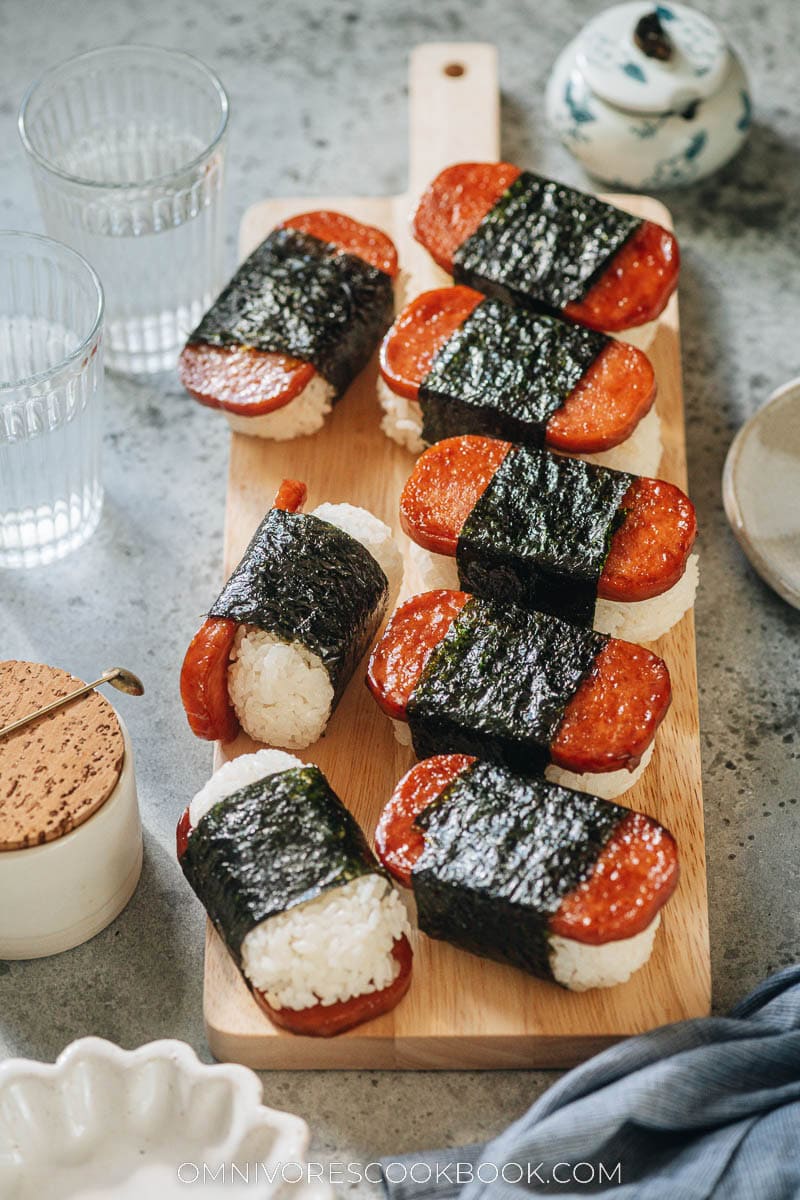
Spam & Chinese cooking
The word Spam might make you think of high-sodium military rations. But in China, Spam is a popular ingredient that people use in comfort food. Spam and pepper stir fry, Spam omelet, Spam ramen, Spam fried rice, or Spam sandwich. You name it.
Spam is also a common ingredient in Chinese Hot Pot and Sichuan Mala Dry Pot – a popular type of Chinese restaurant where you choose a spicy sauce and various ingredients that are cooked in it and then everything is served in a big pot. Every time I go to Mala Pot restaurants with friends, I remember to order a few slices of Spam and it’s always the most popular ingredient in the pot.
Spam is so intertwined with Chinese food culture that I’d never considered Spam a foreign food until I moved the US. Then I started to wonder when it came to China.
After some digging, I found out the following. According to Wikipedia:
“In China, Hormel decided to adopt a different strategy to market Spam, promoting it as a foreign, premium food product and changing the Spam formula to be meatier in order to accommodate local Chinese tastes.”
Apparently, Hormel also decided to name it “luncheon meat” (午餐肉) instead of Spam, to make it sound glamorous. No wonder. Back in old days, Spam was considered a fancy thing that people would serve for dinner on Chinese New Year.
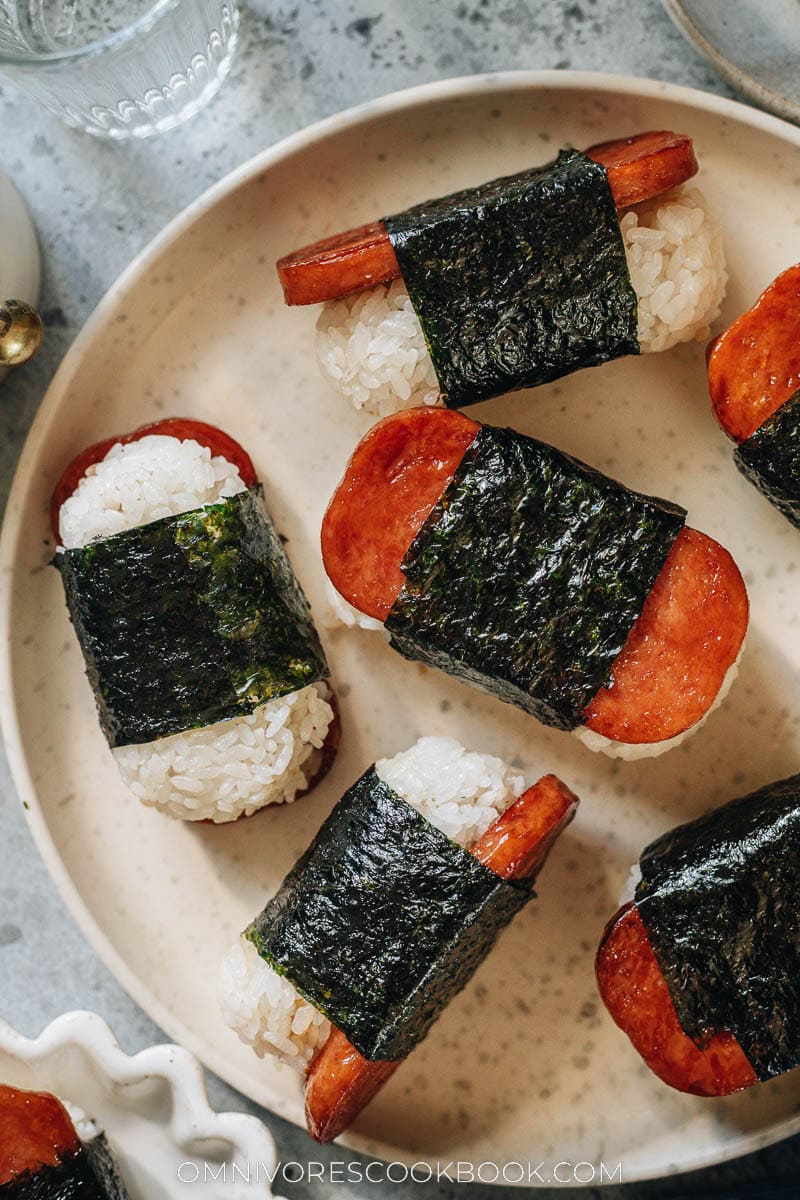
A Common Table Cookbook
This spam musubi recipe is slightly adapted from one in the cookbook A Common Table – 80 Recipes and Stories from My Shared Culture, written by my friend Cynthia Chen McTernan, who is the author behind the award-winning blog Two Red Bowls.
I decided to share her Spam Musubi recipe – a great representation of how Asian food inspired local cuisine and became a part of its culture. Even though I got to know this Hawaiian dish only after moving to the US, it makes me feel nostalgic because of the use of Spam, an ingredient that reminds me of time spent with family and friends.

Spam musubi Ingredients
You only need a few very simple ingredients to make spam musubi:
- Cooked rice
- Spam (I prefer the low sodium type)
- Strips of crispy seaweed (nori)
- Soy sauce and sugar for seasoning
Experiment with sushi rice
The original Hawaiian spam musubi does not use sushi rice, which has added rice vinegar and sugar. But when I make my own spam musubi, I always use sushi rice. The refreshing acidic note cuts the greasiness of the Spam, mellows its saltiness, and works perfectly with the sweet taste.
If you’re feeling adventurous, use the sushi rice recipe from Just One Cookbook. The extra 5 minutes is definitely worth it. Her recipe includes a rice cooker version. Check out this post if you need a detailed instruction on how to make rice on the stovetop.
Seaweed (nori)
Make sure you get the large nori sheet that is about 8” (20 cm) to 9” (22 cm) long. It is usually labeled as sushi nori, yaki nori (roasted seaweed), or laver for Gimbap (if you visit a Korean store). They usually come in large, thin, square packages. And you will need to cut them into strips for this recipe.
How to make spam musubi
Cook the Spam
- Brown the spam until crispy
- Braise the spam with sugar and soy sauce, until the surface is caramelized
It’s very important that you brown the spam slowly and thoroughly. It renders some fat and makes a very crispy crust. Then you will use some sugar and soy sauce mixed with water to quickly braise the Spam. You will end up with a beautifully caramelized dark brown surface that is still chewy and sticky. It’s perfect.

Wrapping the spam musubi
- Place a strip of nori sheet on your working surface, then place the spam at the very end
- Make a ball of rice by pressing it together, then shape it into an oval shape that is similar to the sliced spam
- Roll up the spam and rice using the nori strip
- Make sure to tuck the rice tight enough so the musubi doesn’t fall apart, but not too tight that you tear the nori sheet
- Smear the end of the nori sheet with a bit of water and roll up the musubi, so the nori will stay put.
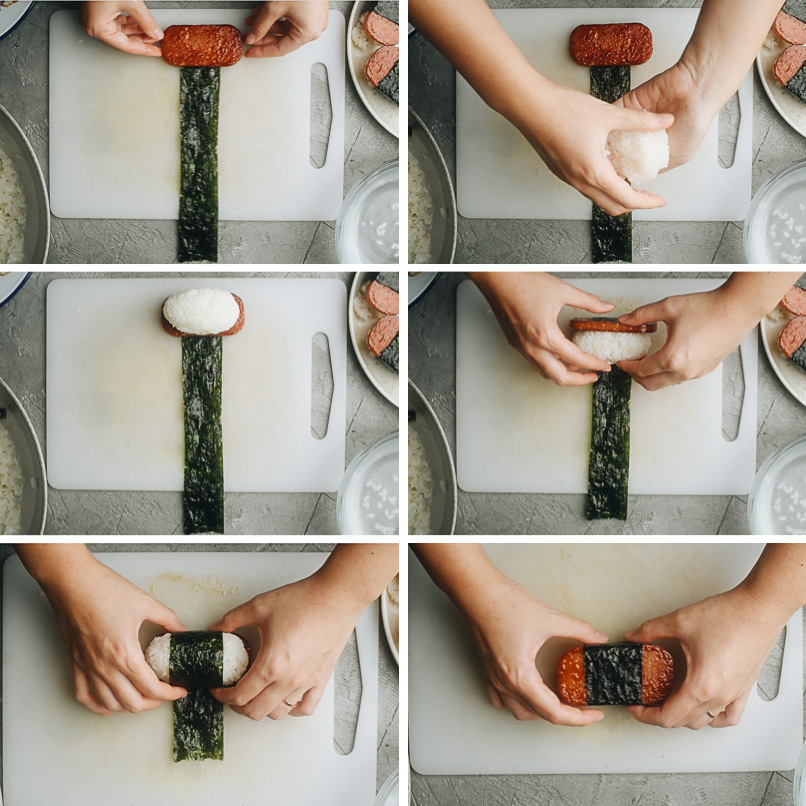
Tips on shaping the rice
You can use a musubi mold to make the rice pressing process much easier and less messy. I only included the traditional way in the recipe, where you use your hands to press the rice. If you like to DIY, you can even use a Spam can to make your own musubi mold (you need to remove the bottom of the can and cut the can a bit shorter).
To make sure the rice doesn’t stick to your hands too much, make sure to always wet your hands before rolling each musubi.
When you press the rice by hand, it’s important to use proper strength so that the rice is pressed together but not overly mashed. If you don’t press enough, the musubi might fall apart when you bite into it. If you press too hard, the rice texture will be too dense. It takes a bit of practice but once you make a few musubi, you’ll get the idea.
How to store and reheat spam musubi
Spam musubi will taste the best when it’s freshly made and you can appreciate the crunchy spam, tender rice, and crispy seaweed. If you serve it within a couple of hours, it’s OK to store them in a container at room temperature. For longer storage, you need to store them in the fridge. If you store them in the fridge, you should always reheat the musubi in a microwave to warm up the rice, to avoid a tough texture.
I’ve not tried freezing spam musubi, but I think it’s totally OK. You should thaw the frozen musubi in the fridge completely, and reheat them before eating.
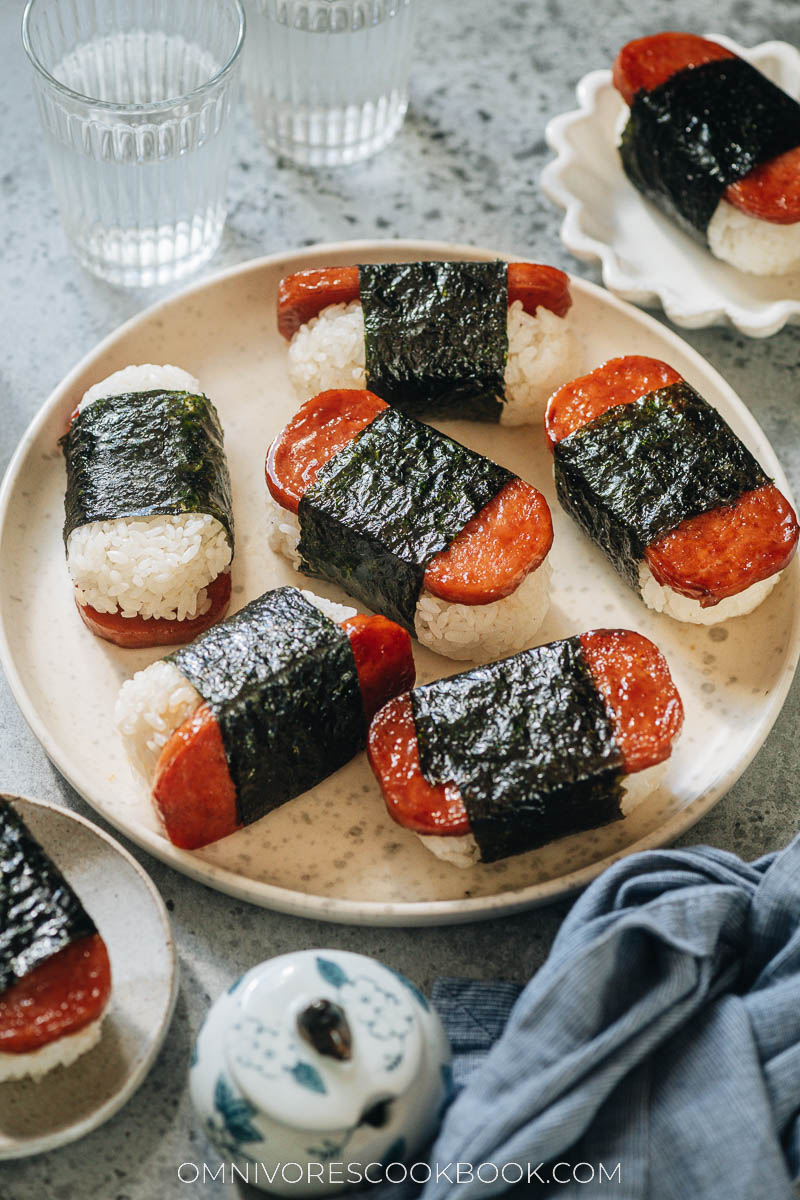
More delicious recipes for your next party
- Air Fryer Chinese Chicken Wings
- Curry Egg Salad Wonton Cups
- Pork Lettuce Wrap (San Choy Bow)
- Old-Beijing Fried Carrot Fritters (炸素丸子)
- Chinese Fried Stuffed Eggplant (炸茄盒, Zha Qie He)
This spam musubi recipe is slightly adapted from the cookbook A Common Table – 80 Recipes and Stories from My Shared Culture, written by my friend Cynthia Chen McTernan
Chinese Cooking Made Easy
Are you new to this website? This free email series is a great place to start. I’ll walk you through a few of my most popular recipes and show you how and why they work. You’ll quickly start to cook better Chinese food in your own kitchen.
Watch video
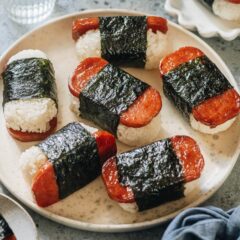
Barter-Worthy Spam Musubi
Ingredients
- 1 teaspoon vegetable oil
- 1 can low-sodium Spam (12 oz. / 340 g can) , sliced into 8 pieces
- 1/4 cup water
- 2 teaspoons soy sauce
- 2 tablespoons sugar
- 4 cups cooked sushi rice (or regular cooked short grain white rice) (*Footnote)
- 3 sheets roasted seaweed (nori) , cut into 8 strips about 2” (5 cm) wide and 9” (23 cm) long
Instructions
- Start making steamed rice (or sushi rice) if you don’t have any already made.
- Heat the oil in a 12-inch (30cm) nonstick or well-seasoned cast-iron skillet over medium heat. Add the Spam slices and cook until browned and crispy on the bottom side, 2 to 3 minutes. Flip and cook until the other side is also browned and crispy, 2 to 3 minutes.
- Whisk together the water and soy sauce in a small bowl. Sprinkle the sugar evenly over the Spam slices, then add the soy sauce mixture. Swirl to evenly distribute, then let the Spam simmer until the liquid is nearly absorbed, 3 to 4 minutes. Flip once in between, so the sugar will melt completely and camalize well. Transfer the Spam slices to a plate to cool.
- To make the sushi: Place one slice of Spam perpendicular to the nori strip on the bottom of the strip (forming a cross shape). Wet the palms and fingers of both of your hands, measure 1/2 cup of rice, and transfer the rice to your palm. Use both hands to firmly press the rice into a ball. Then hold the rice ball with your left hand, with your thumb and the other four fingers to secure both sides, use your right hand to gently press the rice ball into a rectangular shape about the size of the Spam slice. Place the rice on top of the Spam. Roll up the Spam and rice so that the nori sheet wraps around it. Seal the end with a bit of water and place the musubi seam-side-down while you work on the rest. Repeat with the remaining nori strips, Spam slices, and rice. Remember to rinse your hands every time, to minimize rice sticking to your hands.
- Enjoy the spam musubi immediately at room temperature. You can store them in an airtight container or wrap them with plastic wrap and place them in the fridge. To serve refrigerated musubi, warm them in the microwave for 20 seconds or so, to get the best texture.
Notes
- A couple of notes on the rice:
When making sushi rice, always use short grain rice. Medium and long grain rice are less starchy and don’t hold together well when pressed into sushi or musubi.
The original recipe uses regular steamed rice, and so do most Hawaiian Spam musubi recipes.
However, I personally prefer making sushi rice, which contains rice vinegar and sugar. The acid and mild sweetness of the sushi rice complement the salty Spam and create more depth of flavor.
You will use about 3 1/2 cup to 4 cups of cooked rice for this recipe. I found my personal favorite ratio is: slice the Spam into 8 slices, and use 1/2 cup of cooked rice per musubi. In my case, I used 4 cups of cooked sushi rice, which were yielded from 2 rice-cooker cups (180ml per cup) of raw short grain rice.
Nutrition

Did you make this recipe?
I’d love to hear how it turned out for you! Please take a moment to leave a 5-star rating ⭐️ and share your thoughts in the comments further down the page. It really helps others discover the recipe too.

Martha LeTarte
I can always eat my weight in dim sum, ramen (actually ANY noodle soup), crispy salt and pepper squid, egg tarts, hot pot, Beijing duck, Korean grilled BBQ, summer rolls and if I’m being honest, I’d attempt to live off baobing. Lol Oh, and one time on Instagram, I posted about a self made Washington D.C. bánh mì challenge. Basically my best friend and I ate around 10 sandwiches each to determine a winner. Because, why not? Haha
I adore cooking to the point that my two favorite pots are my Dutch oven and stove top pressure cooker. I always look forward to your Instagram posts and attempt to harness and channel your authentic flavors. Thank you for sharing what you love to do with all of us!
Also, I truly enjoy the aesthetic of your food photography.
Rosanna Martinez Schwarz
All my friends and family tell me I have an Asian Heart and Soul inside a Mexican body! LOL! I love Congee, Phó Dac Biet, Mi Hoanh Thanh, Ommu Rice, Kimchi Chigae, Soon Saw, Laap, anything Spam! I can keep going! Thank you for this recipe it will help me get through busy days at salon!
Della
My current favorites are scallion pancakes and mapo tofu. Thanks for having this giveaway 🙂
Ann Cheah
Char siew and siew yuk are definitely my fav!
Carole Nickel
I thouroughly enjoy your blog, thr ecipes and the stories.
Great to get to the source.
Nevertheless, chicken wanton soup and ramen soup remain my favorites
christine kwak
kimchi soup with pork belly, served with rice, fried egg, and seaweed, is my ultimate comfort food! I also love taiwanese popcorn chicken, and beef noodle soup! and spicy fish … oh, and oxtail soup for when I’m feeling tired or sick. Different days call for different favorites! Asian food = home 🙂
Desiree
If I had to pick just one, it’d probably be mapo tofu.
Jay
I’ll try my next spam musube with sushi rice. I like it with it fully covered with the seaweed and sandwiched with the rice and nori komi furikake sprinkled. I sometimes add a slice of egg omelet with the spam with a dab of ketchup😁
Shannon Chin
Pork fried rice, egg rolls and pot stickers are just a few of my favorites! Please enter me into the drawing? Thanks so much!!!
Shannon Chin
Hello! Some of my favorite Chinese recipes are of course pork fried rice, chow mein, egg rolls, pot stickers. Wor won ton soup!!!
Angela hui
Oh god, there are so many amazing Chinese recipes out there it’s like choosing your favourite parent! I know it’s simple, but I’m such a sucker for 雪菜肉絲米粉! Shredded with preserved salted cabbage and vermicelli noodle soup! My mum used to make this dish a lot for breakfast for me as a kid! It’s my ultimate comfort food!
Vlad
My favorite dish is Sichuan eggplant stir fry!
Nancy Sujo
Spam musubi is one of my favorite snacks, sometimes meal!! Sooo good!! I miss Hawaii everytime I eat it!!
Sonya
Of course this is hands down easy. Eggrolls! My husband travels for work and is always gone for months up to at least a year. And he LOVES to cook. Because hes always away from home , he uses his cooking to meet and get to know people from all walks of life. And on one of his jobs he met an older lady(a grandmother, I forget from where) who gave/taught him this awesome egg roll recipe. The next time he went home he shared it with his mom(whose an unbelievable cook) and its been a family tradition ever since. His family, mom, grandma, sisters, cousins,neices and nephews, get together and they make an assembly line and everyone participates on chopping, cooking, rolling and frying. And years later he met me and I was included and accepted(and tested on my rolling skills lol) into the tradition. The recipe is awesome. We never make less than 250-300 because they are that good and its hard to stop eating them. But I think what really brings it home is the fact that they keep his family together. That bonding time is precious and something you can never replace. And with him being on the road a lot… he eats ever ounce of it up. No recipe matters if it you cant share it with those you love.
shirley wolfe
I have sure enjoyed your news and have tried lots of your recipes. My family love the Chinese and Asian food. I would like a recipe for tomato beef chow mane. also enjoyed your demo how to use the chopsticks.
Della
My current favorites are mapo tofu & scallion pancakes. Thanks for having this giveaway 😊
Dan Mackin
A lot of the meals we enjoy come from your website, we especially enjoy your stir fry procedure advise.
Mikayla
I wish I could try all of your recipes!! If I could narrow my favourite Asian foods down I would have to choose wonton soup, xiau long bao, and Szechuan green beans!
Joyce der
Love your website! Fav dish is ma po tofu. Am trying to eat more plant based Whole Foods and less beef, pork. no dairy or eggs. It is difficult coz I love all food, especially Asian. Love getting inspired by looking at cookbooks
Mikayla Mah
Oh wow what a delicious looking recipe! I don’t think I can pick a favourite Asian food. If I had to narrow it down, I think I’d say wonton soup, xiau long bao, and Szechuan green beans. I can’t wait to continue seeing more amazing recipes!
Tim New
I’m a US citizen living in Shenzhen at the moment. I love Dumplings (Jiǎo) of almost any style or flavor, Ma Po Tofu, Sichuan Hot Pot (I haven’t tried Chongqing hot pot yet), a millet ball I had in Harbin and many vegetable dishes – Here they eat pea leaves, and Chrysanthemum leaves. I also love the fruit teas but haven’t found a recipe to make my own.